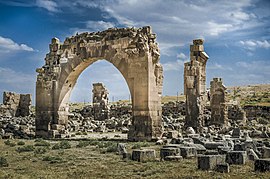
Back Harran Afrikaans ካራን Amharic حران (تركيا) Arabic ܚܪܢ ARC Харан Byelorussian Харан Bulgarian Harran Catalan ХӀарран CE Harran İlçesi CEB حەڕان CKB
Harran | |
|---|---|
District and municipality | |
 | |
 Map showing Harran District in Şanlıurfa Province | |
| Coordinates: 36°52′15″N 39°01′30″E / 36.87083°N 39.02500°E | |
| Country | Turkey |
| Province | Şanlıurfa |
| Established | c. 2500–2000 BC |
| Government | |
| • Mayor | Mahmut Özyavuz (MHP) |
Area | 904 km2 (349 sq mi) |
| Elevation | 360 m (1,180 ft) |
| Population (2022)[1] | 96,072 |
| • Density | 110/km2 (280/sq mi) |
| Time zone | UTC+3 (TRT) |
| Postal code | 63510 |
| Area code | 0414 |
| Website | www |
Harran[a] is a municipality and district of Şanlıurfa Province, Turkey.[2] Its area is 904 km2,[3] and its population is 96,072 (2022).[1] It is approximately 40 kilometres (25 miles) southeast of Urfa and 20 kilometres (12 miles) from the Syrian border crossing at Akçakale.
Harran was founded at some point between the 25th and 20th centuries BC, possibly as a merchant colony by Sumerian traders from Ur. Over the course of its early history, Harran rapidly grew into a major Mesopotamian cultural, commercial and religious center. It was made a religiously and politically influential city through its association with the moon-god Sin; many prominent Mesopotamian rulers consulted with and renovated the moon-temple of Ekhulkhul in Harran. Harran came under Assyrian rule under Adad-nirari I (r. 1305–1274 BC) and became a provincial capital often second in importance only to the Assyrian capital of Assur itself. During the collapse of the Assyrian Empire, Harran briefly served as the final capital of the Neo-Assyrian Empire (612–609 BC).
The city continued to be prominent after the fall of Assyria and experienced varying degrees of foreign cultural influence during its time under the Neo-Babylonian (609–539 BC), Achaemenid (539–330 BC), Macedonian (330–312 BC) and Seleucid (312–132 BC) empires. During classical antiquity Harran was often contested between the Roman and Parthian (later Sasanian) empires. In 53 BC Harran was the site of the Battle of Carrhae, one of the worst military defeats in Roman history. The Harranian moon cult of Sin proved to be enduring and lasted long into the Middle Ages, known to have existed as late as the 11th century AD. Harran was captured by the Rashidun Caliphate in 640 and remained an important city in the Islamic period. It flourished as a center of science and learning and was the site of both the first Islamic university (the Harran University)[4][b] and the oldest mosque in Anatolia[c] (the Harran Grand Mosque).[6] Harran twice served as a capital city in the Middle Ages, first briefly under the Umayyad Caliphate (744–750) and later under the Numayrid Emirate (990–1081).
The city was conquered by the Mongol Empire in 1260 but was largely destroyed and left abandoned in 1271. Although Harran was kept as a military outpost under some later regimes, it has over the last five centuries mainly been used as a temporary settlement by local nomadic societies. Harran transitioned back into a semi-permanent village settlement in the 1840s, but has only recently grown into a permanent town through advancements in local irrigation and agriculture. Harran was a Turkish district until 1946, after when it was downgraded to a sub-district of the Akçakale district. It regained its status as a district in 1987.[7] Today, it is a major local tourist spot. The town is particularly famous for its unique beehive houses, which are reminiscent of buildings that were already present at Harran in ancient Mesopotamian times.
- ^ a b Cite error: The named reference
tuikwas invoked but never defined (see the help page). - ^ Büyükşehir İlçe Belediyesi, Turkey Civil Administration Departments Inventory. Retrieved 19 September 2023.
- ^ "İl ve İlçe Yüz ölçümleri". General Directorate of Mapping. Retrieved 19 September 2023.
- ^ Frew 1999.
- ^ harran.edu.tr.
- ^ Binici et al. 2020, p. 1021.
- ^ "Harran". sanliurfa.gov.tr. Retrieved 27 September 2022.
Cite error: There are <ref group=lower-alpha> tags or {{efn}} templates on this page, but the references will not show without a {{reflist|group=lower-alpha}} template or {{notelist}} template (see the help page).

